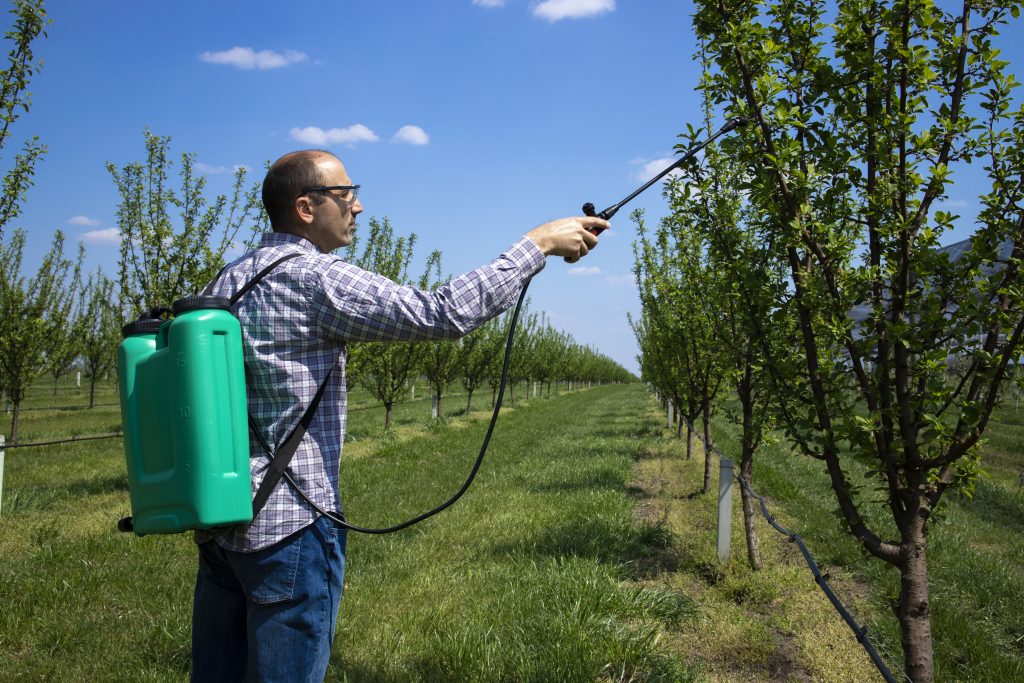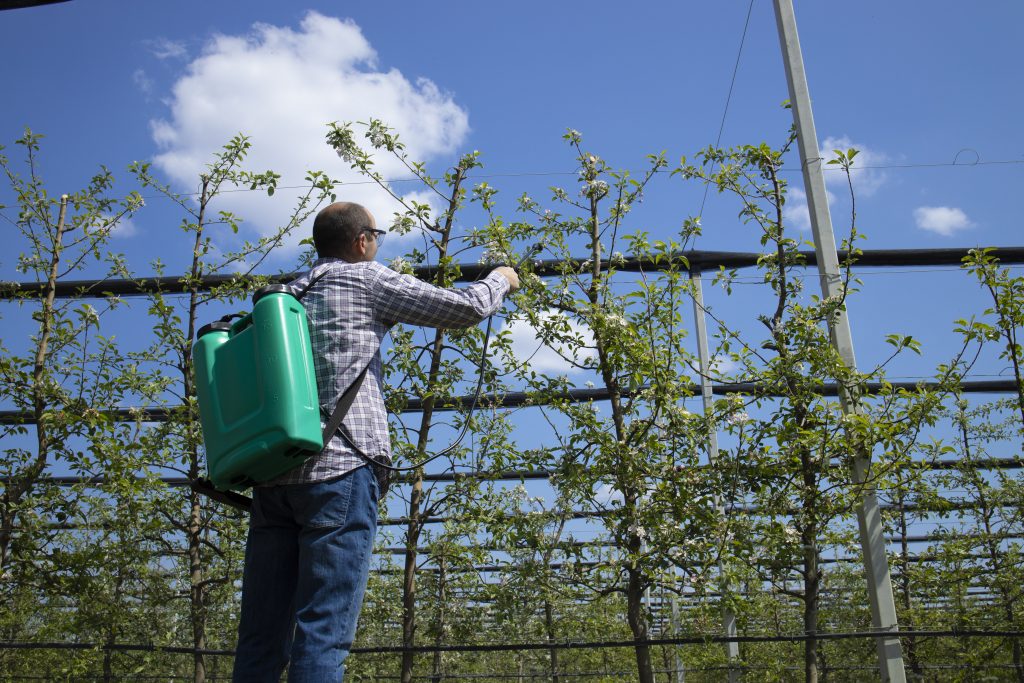THE PROS AND CONS OF USING HERBICIDES AROUND TREES
THE PROS AND CONS OF USING HERBICIDES AROUND TREES
Weed control is essential for maintaining the health and vitality of trees. Weeds, which are invasive and unwanted plant species, can have detrimental effects on trees and their surrounding environment. Proper weed control practices are crucial to ensure that trees receive the necessary resources and support for optimal growth. Here’s why weed control is important for tree health:

- Competition for Resources: Weeds compete with trees for essential resources such as water, nutrients, and sunlight. In a competitive environment, trees may struggle to access the resources they need to thrive.
- Nutrient Depletion: Weeds often have rapid growth rates and aggressive root systems. They can deplete soil nutrients, leaving less available for trees. This nutrient competition can lead to stunted tree growth and nutrient deficiencies.
- Water Stress: Weeds consume significant amounts of water from the soil, which can lead to water stress for trees, especially during periods of drought. Reduced water availability can weaken trees and make them more susceptible to pests and diseases.
- Physical Damage: Weeds growing close to trees can cause physical damage by rubbing against branches or trunks. This damage can create entry points for diseases and pests.
- Habitat for Pests: Weeds can serve as habitats for pests, such as insects and rodents, that can damage trees. Effective weed control can reduce the presence of these pests, minimizing potential harm to trees.
- Air Circulation and Sunlight Access: Dense weed growth can block airflow and sunlight from reaching the lower branches of trees. Proper air circulation and sunlight exposure are vital for overall tree health.
- Root Competition: Weeds with invasive root systems can compete with tree roots for space in the soil. This can lead to root entanglement and reduced root function, affecting tree stability and nutrient uptake.
- Disease Spread: Weeds can harbor diseases that may spread to nearby trees. Removing weeds reduces the potential for disease transmission and improves overall tree health.
- Aesthetic Value: Uncontrolled weed growth can negatively impact the visual appeal of the landscape. Removing weeds enhances the aesthetic value of the area, especially when paired with well-maintained trees.
- Resource Allocation: Trees invest energy in producing leaves, flowers, and fruits. When competing with weeds, trees may allocate more resources to growth and less to reproductive efforts, affecting fruit production and overall tree vigor.
- Long-Term Impact: Neglecting weed control over time can lead to chronic stress on trees, which makes them more susceptible to secondary issues such as pests, diseases, and environmental stressors.
In summary, effective weed control is crucial for maintaining healthy and vibrant trees. By reducing competition for resources, minimizing stress, and creating a favorable environment for growth, weed management practices contribute to the long-term health, stability, and aesthetics of trees in landscapes and natural settings.
Herbicides and their Role in Weed Management
Herbicides are chemical substances designed to control or eliminate unwanted plants, commonly known as weeds. They are an essential tool in weed management strategies for various agricultural, horticultural, and landscaping purposes. Herbicides work by interfering with specific physiological processes in plants, leading to their growth inhibition or eventual death. Their role in weed management is to help control weed populations and reduce their negative impact on desired crops, plants, and ecosystems.

Here’s how herbicides work and their role in weed management:
- Selective vs. Non-Selective Herbicides:
- Selective herbicides target specific types of plants, allowing the desired plants to grow without interference. These are commonly used in situations where specific weeds need to be controlled without harming surrounding vegetation.
- Non-selective herbicides, on the other hand, target a broad range of plant species and are often used to clear areas completely of vegetation, such as before planting new crops or in areas where no vegetation is desired.
- Modes of Action: Herbicides work through various modes of action, affecting different plant processes. Some common modes of action include inhibiting photosynthesis, disrupting cell growth, interfering with hormonal processes, and damaging cell membranes.
- Contact vs. Systemic Herbicides:
- Contact herbicides kill the parts of the plant they directly come into contact with, usually the foliage. They are effective on annual weeds and grasses.
- Systemic herbicides are absorbed by the plant and then translocated throughout its system, affecting even the roots. They are effective on perennial weeds and plants with extensive root systems.
- Pre-Emergent vs. Post-Emergent Herbicides:
- Pre-emergent herbicides are applied before weed seeds germinate. They form a barrier in the soil that prevents weed seedlings from establishing.
- Post-emergent herbicides are applied to actively growing weeds. They are effective against weeds that have already emerged from the soil.
- Benefits of Herbicides in Weed Management:
- Efficiency: Herbicides can quickly and efficiently control large weed populations, saving time and labor compared to manual methods.
- Precision: Selective herbicides can target specific weed species while sparing desirable plants.
- Cost-effectiveness: Herbicides can be cost-effective, especially for large-scale weed control.
- Reduced Soil Disturbance: Herbicide application minimizes soil disruption compared to mechanical methods.
- Conservation of Water and Soil: By controlling weeds, herbicides help conserve water and prevent soil erosion caused by aggressive weed growth.
- Considerations and Limitations:
- Environmental Impact: Herbicides can have environmental consequences, including soil and water contamination if not used properly.
- Health and Safety: Proper handling and protective measures are essential to prevent human and animal exposure to herbicides.
- Resistance: Repeated use of the same herbicide can lead to the development of herbicide-resistant weed populations.
- Integration: Herbicides should be part of an integrated weed management strategy that includes cultural, mechanical, and biological methods.
In conclusion, herbicides play a crucial role in weed management by effectively controlling unwanted vegetation. When used responsibly and as part of a comprehensive strategy, herbicides can contribute to healthier landscapes, improved crop yields, and more sustainable land management practices.
Benefits and Drawbacks of Herbicide Use Around Trees
Using herbicides around trees can offer both benefits and drawbacks, depending on the specific circumstances, the types of herbicides used, and the methods of application. Here’s an overview of the pros and cons of herbicide use around trees:

Benefits:
- Effective Weed Control: Herbicides can effectively control weeds that compete with trees for resources such as water, nutrients, and sunlight. This promotes tree health and growth by reducing competition.
- Labor and Time Savings: Herbicide application is generally quicker and requires less labor compared to manual methods of weed removal. This is especially advantageous for large areas or properties with numerous trees.
- Selective Application: Selective herbicides can target specific weed species while sparing desirable trees and vegetation. This precision minimizes the impact on non-target plants.
- Root Zone Protection: Some herbicides can be applied to the soil around trees, forming a barrier that prevents weed growth within the tree’s root zone. This helps maintain a weed-free area around the tree.
- Reduced Soil Disturbance: Herbicide application involves minimal soil disturbance compared to mechanical weed removal methods, which can help preserve soil structure and minimize erosion.
- Reduced Water Stress: Controlling weeds around trees reduces their water consumption, which is especially important during drought conditions. Trees can access water and nutrients more efficiently.
- Enhanced Aesthetics: Herbicide use can improve the visual appearance of the area around trees, enhancing the overall landscape design.
Drawbacks:
- Non-Target Effects: Misapplication or drift of herbicides can affect non-target plants, including desirable vegetation and native species, leading to unintended damage.
- Soil and Water Contamination: Some herbicides can leach into the soil or run off into water bodies, potentially contaminating the environment and harming aquatic ecosystems.
- Health and Safety Risks: Herbicide exposure poses risks to humans, animals, and beneficial insects. Airborne particles or residues can lead to inhalation or skin contact.
- Resistance Development: Over time, repeated use of the same herbicide can lead to the development of herbicide-resistant weed populations, making future control more challenging.
- Long-Term Environmental Impact: Persistent herbicides can remain in the environment, affecting soil health, water quality, and ecosystems over an extended period.
- Limited Root Uptake: Some herbicides can affect trees if taken up through their root systems. Care must be taken to avoid harming trees while targeting weeds.
- Cost: Herbicide application costs can include the purchase of herbicides, equipment, and professional application services, which may be a consideration for some property owners.
- Public Perception: The use of herbicides can be a subject of public concern, particularly in areas where chemical use is discouraged due to perceived environmental risks.
In conclusion, the decision to use herbicides around trees should be based on a thorough assessment of the specific situation, including the types of weeds, tree species, local regulations, and environmental considerations. When used judiciously and as part of an integrated approach to weed management, herbicides can provide benefits while minimizing potential drawbacks. It’s essential to prioritize tree health, environmental stewardship, and responsible herbicide application practices.
Pros and Cons of Using Herbicides
Using herbicides comes with a range of pros and cons that should be carefully considered based on the specific context, goals, and environmental considerations. Here’s a breakdown of the advantages and disadvantages of using herbicides:
Pros of Using Herbicides:
- Effective Weed Control: Herbicides are often highly effective at controlling weeds and invasive plant species that can compete with desired plants for resources.
- Time and Labor Savings: Herbicide application can be more efficient and require less manual labor compared to mechanical or manual weed removal methods.
- Precision: Selective herbicides can target specific weed species while sparing desired plants, minimizing damage to non-target vegetation.
- Large-Scale Management: Herbicides are well-suited for managing large areas with extensive weed populations, making them practical for agricultural and commercial applications.
- Reduced Soil Disturbance: Herbicide application avoids the soil disruption that can occur with mechanical weed removal methods, helping to preserve soil structure.
- Prevention of Seed Production: Herbicides can prevent weeds from producing seeds, reducing the weed seed bank and future weed growth.
- Conservation of Water and Soil: Effective weed control helps conserve water and prevent soil erosion, as invasive weeds often consume significant water and contribute to soil loss.
Cons of Using Herbicides:
- Non-Target Effects: Misapplication or drift of herbicides can harm non-target plants, including desirable vegetation and native species, leading to unintended ecological consequences.
- Soil and Water Contamination: Some herbicides can leach into the soil or runoff into water bodies, potentially contaminating groundwater and aquatic ecosystems.
- Health and Safety Risks: Herbicide exposure poses risks to humans, animals, and beneficial insects. Handling and application must adhere to safety guidelines to prevent harm.
- Resistance Development: Repeated use of the same herbicide can lead to the development of herbicide-resistant weed populations, rendering future control efforts less effective.
- Long-Term Environmental Impact: Persistent herbicides can persist in the environment, affecting soil health, water quality, and non-target plants and organisms.
- Public Perception: The use of herbicides can raise concerns among the public due to perceived health risks and potential harm to the environment.
- Regulatory Considerations: Herbicide use is subject to regulations and restrictions that vary by region and may require permits or professional applicators.
- Cost: The cost of purchasing herbicides, equipment, and professional application services can be a significant factor for some individuals or organizations.
- Loss of Biodiversity: Indiscriminate herbicide use can contribute to a reduction in plant diversity and disrupt local ecosystems.
- Alternative Methods: Relying solely on herbicides may discourage the exploration of other integrated pest management techniques that could provide effective and sustainable solutions.
About Murray, Utah
Murray is a city situated on the Wasatch Front in the core of Salt Lake Valley in the U.S. state of Utah. Named for territorial governor Eli Murray, it is the state's fourteenth largest city. According to the 2020 census, Murray had a population of 50,637. Murray shares borders with Taylorsville, Holladay, South Salt Lake and West Jordan, Utah. Once teeming with heavy industry, Murray's industrial sector now has little trace and has been replaced by major mercantile sectors. Known for its central location in Salt Lake County, Murray has been called the Hub of Salt Lake County. Unlike most of its neighboring communities, Murray operates its own police, fire, power, water, library, and parks and recreation departments and has its own school district. While maintaining many of its own services, Murray has one of the lowest city tax rates in the state.
Neighborhoods in Murray, Utah
Murray Oakes, Grant Park, Southwood Park, Murray Park, Murray Park Restrooms, Willow Pond Park, Neighborhood Veterinary Care
Things To Do in Murray, Utah
Bus Stops in Murray, Utah to Truco Services, Inc.
Bus Stop in Murray Central Station (Bay C) Murray, Utah to Truco Services, Inc.
Bus Stop in State St @ 4801 S Murray, Utah to Truco Services, Inc.
Bus Stop in Murray North Station Murray, Utah to Truco Services, Inc.
Bus Stop in State St @ 4949 S Murray, Utah to Truco Services, Inc.
Bus Stop in Murray Central Frontrunner/Trax Station Murray, Utah to Truco Services, Inc.
Bus Stop in Murray Blvd / Vine St (SB) Murray, Utah to Truco Services, Inc.
Bus Stop in State St @ 3925 S Murray, Utah to Truco Services, Inc.
Bus Stop in State St @ 4824 S Murray, Utah to Truco Services, Inc.
Bus Stop in State St @ 5223 S Murray, Utah to Truco Services, Inc.
Bus Stop in Murray Blvd / Allendale Dr (NB) Murray, Utah to Truco Services, Inc.
Bus Stop in Murray Blvd @ 5039 S Murray, Utah to Truco Services, Inc.
Bus Stop in State St @ 4721 S Murray, Utah to Truco Services, Inc.
Driving Directions in Murray, Utah to Truco Services, Inc.
Driving Directions from Woodruff Tree Trimming and Removal to 4640 Commerce Dr, Murray, UT 84107, USA
Driving Directions from Reliable Tree Care to 4640 Commerce Dr, Murray, UT 84107, USA
Driving Directions from Tree Pro-Tech to 4640 Commerce Dr, Murray, UT 84107, USA
Driving Directions from Prestige Tree And Landscape to 4640 Commerce Dr, Murray, UT 84107, USA
Driving Directions from Excellence Tree & Landscape to 4640 Commerce Dr, Murray, UT 84107, USA
Driving Directions from Amen Trees to 4640 Commerce Dr, Murray, UT 84107, USA
Driving Directions from Tim's Tree Care to 4640 Commerce Dr, Murray, UT 84107, USA
Driving Directions from Jordan Tree Service - Murray to 4640 Commerce Dr, Murray, UT 84107, USA
Driving Directions from Arbor Works to 4640 Commerce Dr, Murray, UT 84107, USA
Driving Directions from Diamond Tree Experts to 4640 Commerce Dr, Murray, UT 84107, USA
Driving Directions from Green Tree Arborist to 4640 Commerce Dr, Murray, UT 84107, USA
Driving Directions from TruCo Services to 4640 Commerce Dr, Murray, UT 84107, USA
Reviews for Truco Services, Inc. Murray, Utah
Emily Abercrombie
We had a great experience with TruCo! They were well priced, responsive and prompt. Michael was a pleasure to work with and gave us advice on which plants to put in where we took out our ugly old shrubs. I would highly recommend this company!!!
Michelle Turpin
TruCo Services gets 5 stars from us for customer service. We experienced a few issues with their services this last year and Rob Eccles in senior management, stepped in and immediately handled our issues. He was very committed to making sure they understood our expectations and would execute to make us happy.
Siobhan Billingsley
I work for a property management company and have the pleasure of working with Rob at a community in Sandy. He has been incredible to work with and always responds in a timely manner. He knows all the homeowners by name and address and is aware of all the "problem" areas when it comes to sprinklers. I never have to worry about following up with him because he always reaches out to provide me with an update. If you're looking to work with someone who takes pride in their job, is professional, and can solve the worst landscaping problems thrown your way, Rob is your guy. Thank you, Rob for all you do!
Jaime S.
We have used Truco at 2 of the complexes we manage, they have been great to work with. Good quality service, outstanding customer service with good communication. That's hard to find these days. I highly recommend them. Travis has been awesome to work with.
Jerusha Smart
We use TruCo for a majority of our properties and our home. While other landscaping companies we use come and go for various reasons like cost, communication issues, work performance, etc., TruCo is always consistent in price and work. Also, Rob is the best.






